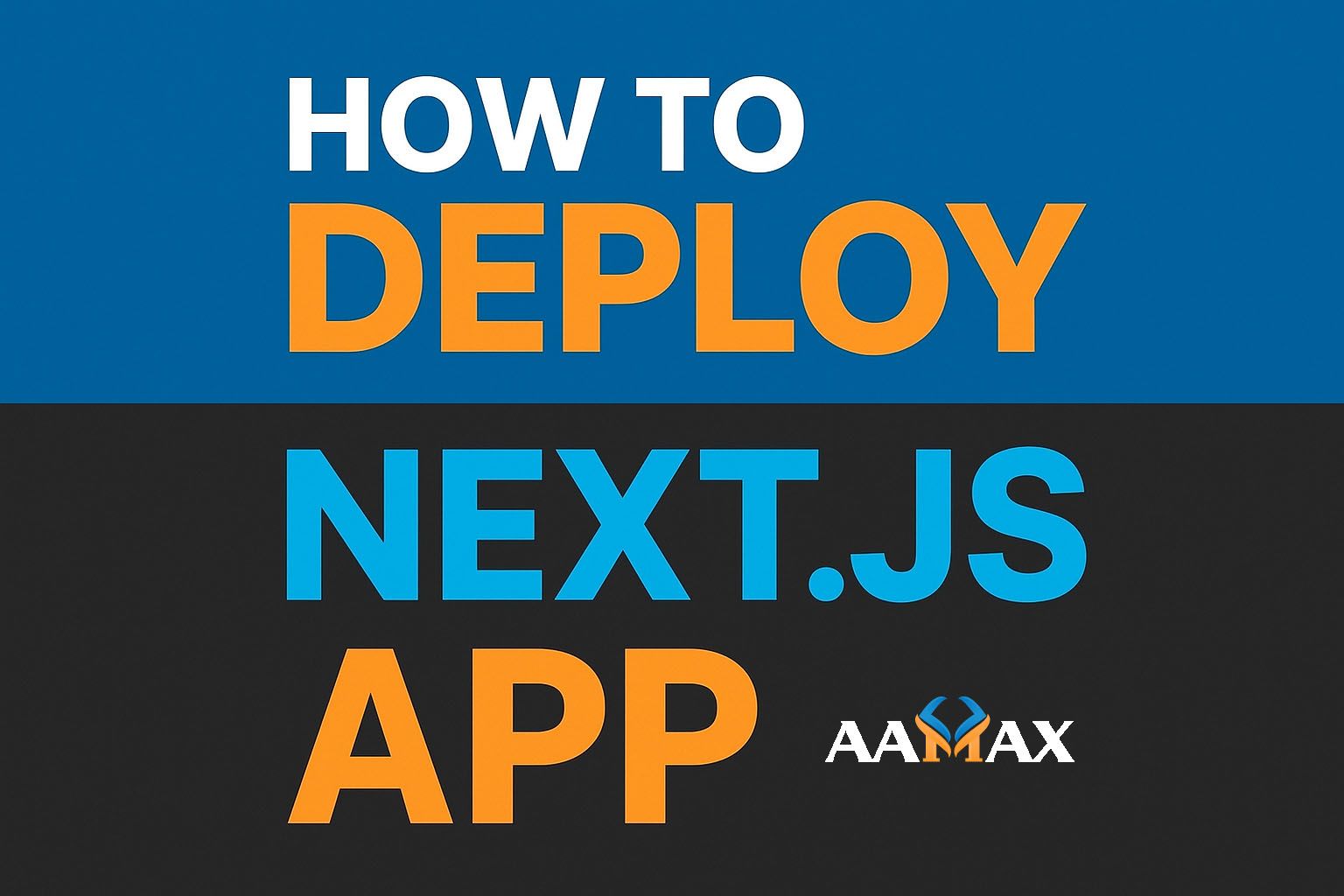
How To Deploy Next JS App
Deploying a Next.js application might seem challenging at first, but with the right approach and tools, you can make the process seamless and efficient. Whether you’re building a portfolio site, an eCommerce platform, or a SaaS product, understanding how to properly deploy your Next.js app ensures better performance, scalability, and user experience.
This guide will walk you through how to deploy a Next.js app using different methods, from Vercel (the official platform) to custom servers like AWS, DigitalOcean, and cPanel. We'll also share some best practices and optimization tips to make your deployment smoother.
🚀 What is Next.js and Why Deployment Matters
Next.js is a React-based framework for building fast, SEO-friendly, and scalable web applications. It supports Server-Side Rendering (SSR), Static Site Generation (SSG), and API routes, which make it a versatile choice for developers.
However, deployment can differ depending on how you’ve configured your project. You might be using dynamic routes, server functions, or static exports — and each affects how you deploy.
Proper deployment ensures:
- Fast load times (optimized by the host and CDN)
- Minimal downtime
- Better SEO and user experience
- Easier scaling as your traffic grows
🧰 Prerequisites Before Deployment
Before deploying your Next.js app, ensure you have the following in place:
-
Production Build Ready
- Run:
This creates an optimized production version of your app in thenpm run build.nextfolder.
- Run:
-
Environment Variables Configured
- Add your
.env.productionfile containing necessary environment variables (API keys, base URLs, etc.).
- Add your
-
Dependencies Installed
- Ensure all dependencies are properly installed using:
npm install
- Ensure all dependencies are properly installed using:
-
Code Optimized for Production
- Remove console logs, debug statements, and unnecessary dependencies.
- Use code splitting and lazy loading where possible.
☁️ Method 1: Deploying Next.js App on Vercel
Vercel is the most straightforward way to deploy Next.js apps since it’s created by the same team behind Next.js.
Steps to Deploy:
-
Push Your Code to GitHub, GitLab, or Bitbucket
- Make sure your latest code is committed and pushed to one of these repositories.
-
Connect to Vercel
- Go to the Vercel dashboard and click “New Project”.
- Import your repository from GitHub/GitLab/Bitbucket.
-
Configure Build Settings
- Vercel automatically detects that you’re using Next.js.
- Default build command:
npm run build - Output directory:
.next
-
Add Environment Variables
- Add all required environment variables in the “Environment Variables” section of your project settings.
-
Deploy
- Click Deploy, and Vercel will handle the rest. Your app will be live within seconds.
Pros:
- Zero configuration
- Free plan available
- Automatic SSL and CDN caching
- Continuous deployment from Git
Cons:
- Limited customization compared to manual deployments
🧾 Method 2: Deploying Next.js on cPanel (Shared Hosting)
While Vercel is ideal, many developers prefer deploying on traditional hosting environments like cPanel, especially when managing multiple sites.
Steps to Deploy on cPanel:
-
Build Your App Locally
npm run build npm run exportThis creates a static export of your site inside the
out/directory. -
Upload Files to Public HTML
- Use File Manager or FTP to upload the contents of the
out/folder topublic_html.
- Use File Manager or FTP to upload the contents of the
-
Update Base Paths (If Needed)
- If your app runs in a subfolder, adjust
next.config.js:module.exports = { basePath: '/your-folder-name', };
- If your app runs in a subfolder, adjust
Pros:
- Simple for static websites
- No need for complex configuration
Cons:
- Only suitable for static exports (no SSR)
- Limited scalability
🧠 Method 3: Deploying Next.js App on VPS (DigitalOcean, Linode, AWS EC2)
For advanced control and better performance, Virtual Private Servers (VPS) are an excellent choice. Let’s see how to deploy your app on a Linux-based VPS.
Steps to Deploy:
-
Upload Your Project
git clone https://github.com/yourusername/your-nextjs-app.git cd your-nextjs-app -
Install Node.js and npm
sudo apt update sudo apt install nodejs npm -y -
Install Dependencies
npm install -
Build and Start the App
npm run build npm start -
Set Up PM2 for Process Management
npm install pm2 -g pm2 start npm --name "nextjs-app" -- start pm2 startup pm2 save -
Configure Nginx as a Reverse Proxy
-
Create a configuration file for your app:
sudo nano /etc/nginx/sites-available/nextjs-appAdd the following:
server { listen 80; server_name yourdomain.com; location / { proxy_pass http://localhost:3000; proxy_http_version 1.1; proxy_set_header Upgrade $http_upgrade; proxy_set_header Connection 'upgrade'; proxy_set_header Host $host; proxy_cache_bypass $http_upgrade; } } -
Enable and restart Nginx:
sudo ln -s /etc/nginx/sites-available/nextjs-app /etc/nginx/sites-enabled/ sudo systemctl restart nginx
-
Your app is now live and accessible via your domain.
Pros:
- Full control over server configuration
- Scalable and reliable
- Ideal for production apps with SSR
Cons:
- Requires technical expertise
- Maintenance and security are your responsibility
🌍 Method 4: Deploying with Docker
If you prefer containerization, Docker makes deployments portable and consistent across environments.
Steps:
-
Create a Dockerfile
FROM node:18-alpine WORKDIR /app COPY package*.json ./ RUN npm install COPY . . RUN npm run build EXPOSE 3000 CMD ["npm", "start"] -
Build Docker Image
docker build -t nextjs-app . -
Run the Container
docker run -d -p 3000:3000 nextjs-app -
Deploy to a Cloud Provider
- Use AWS ECS, Google Cloud Run, or Docker Hub to deploy and scale your app easily.
Pros:
- Environment consistency
- Easy to deploy across multiple servers
- Perfect for DevOps pipelines
🧩 Method 5: Deploying Next.js with GitHub Actions (CI/CD)
To automate your deployments, you can integrate GitHub Actions.
Example Workflow:
Create a file .github/workflows/deploy.yml:
name: Deploy Next.js App
on:
push:
branches: [ main ]
jobs:
build:
runs-on: ubuntu-latest
steps:
- uses: actions/checkout@v2
- name: Setup Node
uses: actions/setup-node@v2
with:
node-version: '18'
- run: npm install
- run: npm run build
- run: npm run export
This automates your build process whenever code is pushed to the main branch.
⚙️ Best Practices for Next.js Deployment
-
Use CDN for Static Assets
- Store images, fonts, and videos on a CDN for faster loading.
-
Monitor Performance
- Tools like Google Lighthouse or Vercel Analytics help track performance metrics.
-
Enable Compression
- Gzip or Brotli compression improves loading speeds.
-
Implement Caching
- Cache pages, assets, and API responses to reduce server load.
-
Secure Your App
- Always use HTTPS and manage environment variables securely.
-
Continuous Deployment
- Automate updates using CI/CD for faster iteration cycles.
🧠 Troubleshooting Common Deployment Issues
| Issue | Possible Cause | Solution |
|-|-|--|
| Build fails | Missing dependencies | Run npm install again |
| Blank screen | Routing or asset issue | Check base paths and public URLs |
| 500 error | Environment misconfig | Review .env.production values |
| Slow load time | No caching or CDN | Enable caching and compression |
💼 Why Hire AAMAX for Next.js & MERN Stack Development
If you’re looking to deploy a professional-grade Next.js or MERN stack application, it’s best to work with an experienced development team. AAMAX offers comprehensive Web Development, Digital Marketing, and SEO services to help businesses build high-performance applications that scale.
AAMAX specializes in:
- Full-stack development with React, Next.js, Node.js, and MongoDB
- Scalable app deployment and optimization
- Technical SEO integration for better visibility
- End-to-end digital marketing strategy
Partnering with AAMAX ensures that your app not only runs smoothly but also grows with your business.
🏁 Conclusion
Deploying a Next.js app doesn’t have to be complicated. Whether you choose Vercel for simplicity, VPS for flexibility, or Docker for scalability, the key is to align your deployment method with your project needs.
With proper setup, optimization, and monitoring, your Next.js app can deliver exceptional speed, performance, and reliability.
And if you want a partner to handle everything — from coding to deployment and SEO — consider AAMAX, your trusted full-service digital agency.







